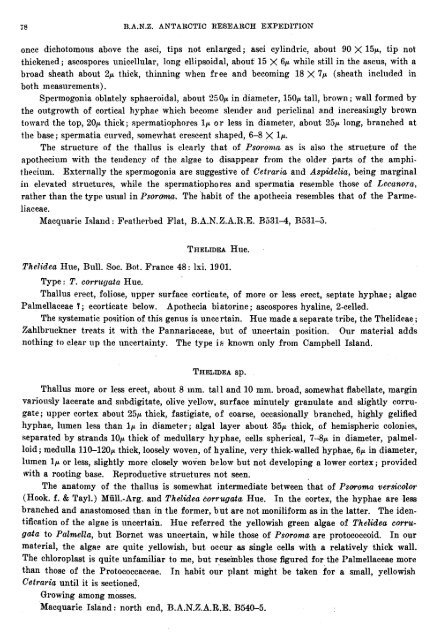You also want an ePaper? Increase the reach of your titles
YUMPU automatically turns print PDFs into web optimized ePapers that Google loves.
78 D.A.N.Z. ANTARCTIC RESEARCH EXPEDITION<br />
once dichotomous above the asci, tips not enlarged; asci cylindric, about 90 X 15~, tip not<br />
thickened; ascospores unicellular, long ellipsoidal, about 15 X 6p while still in the ascus, with a<br />
broad sheath about 2p thick, thinning when free and becoming 18 X 7p (sheath included in<br />
both measurements).<br />
Spermogonia oblately sphaeroidal, about 250~ in diameter, 150p tall, brown; wall formed by<br />
the outgrowth of cortical hyphae which become slendel. and periclinal and increasiiigly brown<br />
toward the top, 20p thick; spermatiophores 1p or less in diameter, about 25p long, branched at<br />
the base; spermatia curved, somewhat crescent shaped, 6-8 X lp.<br />
The structure of the thallus is clearly that of Psoronzn as is also the structure of the<br />
apothecium with the teiidency of the algae to disappear from the older parts of the amphitliecium.<br />
Exterrially the spermogonia are suggestive of Cetraria and Aspidelia, being marginal<br />
in elevated structures, while the spermatiophores and spermatia resemble those of Lccunora,<br />
rather than the type usual in Psormm. The habit of the apothecia resembles that of the Parmeliaceae.<br />
Macquarie Island: Featherbed Flat, B.A.N.Z.A.R.E. R3314, B531-3.<br />
THELIDEA Hue.<br />
Thelidea Hue, Bull. Soc. Bot. France 48: lxi. 1901.<br />
Type : T. corrzigata Hue.<br />
Thallus erect, foliose, upper surface corticate, of more or less erect, septate hyphae; algae<br />
Palmellaceae 9; ecorticate below. Apothecia biatorine; ascospores hyaline, 2-celled.<br />
The systematic position of this genus is uncertain. Hue made a separate tribe, the Thelideae ;<br />
Bahlbrwkner treats it with the Pannariaceae, but of uncertain position. Our material adds<br />
nothing to clear up the uncertainty. The type is knoiim only from Campbell Island.<br />
Thallus more or less erect, about 8 mm. tall and 10 mm. broad, somewhat flabellate, margin<br />
variously lacerate and snbdigitate, olive yellow, surface minutely granulate and slightly corru-<br />
gate; upper cortex about 2Sp thick, fastigiate, of coarse, occasionally branched, highly gelified<br />
hyphae, lumen less than lp in diameter; algal layer about 35p thick, of hemispheric colonies,<br />
separated by strands lop thick of medullary hyphae, cells spherical, 7-8p in diameter, palmel-<br />
loid; medulla 110-120p thick, loosely woven, of hyaline, very thick-walled hyphae, 6p in diameter,<br />
lumen lp or less, slightly more closely woven below but not developing a lower cortex; provided<br />
with a rooting base. Reproductive structures not seen.<br />
The anatomy of the thallus is somewhat intermediate between that of Psoroma versicolor<br />
(Hook. f. & Tayl.) Miill.-Arg. and Thelidea corrugata Hue. In the cortex, the hyphae are less<br />
branched and anastomosed than in the former, but are not moniliform as in the latter. The iden-<br />
tification of the algae is uncertain. Hue referred the yellowish green algae of Thelidea corru-<br />
gata to Palmella, but Bornet was uncertain, while those of Psoroma are protococcoid. In our<br />
material, the algae are quite yellowish, but occur as single cells with a relatively thick wall.<br />
The chloroplast is quite unfamiliar to me, but rese'mbles those figured for the Palmellaceae more<br />
than those of the Protococcaceae. In habit our plant might be taken for a small, yellowish<br />
Cetraria until it is sectioned.<br />
Growing among mosses.<br />
Macquarie Island : north end, B.A.N.B.A.R.E. R540-5.

















